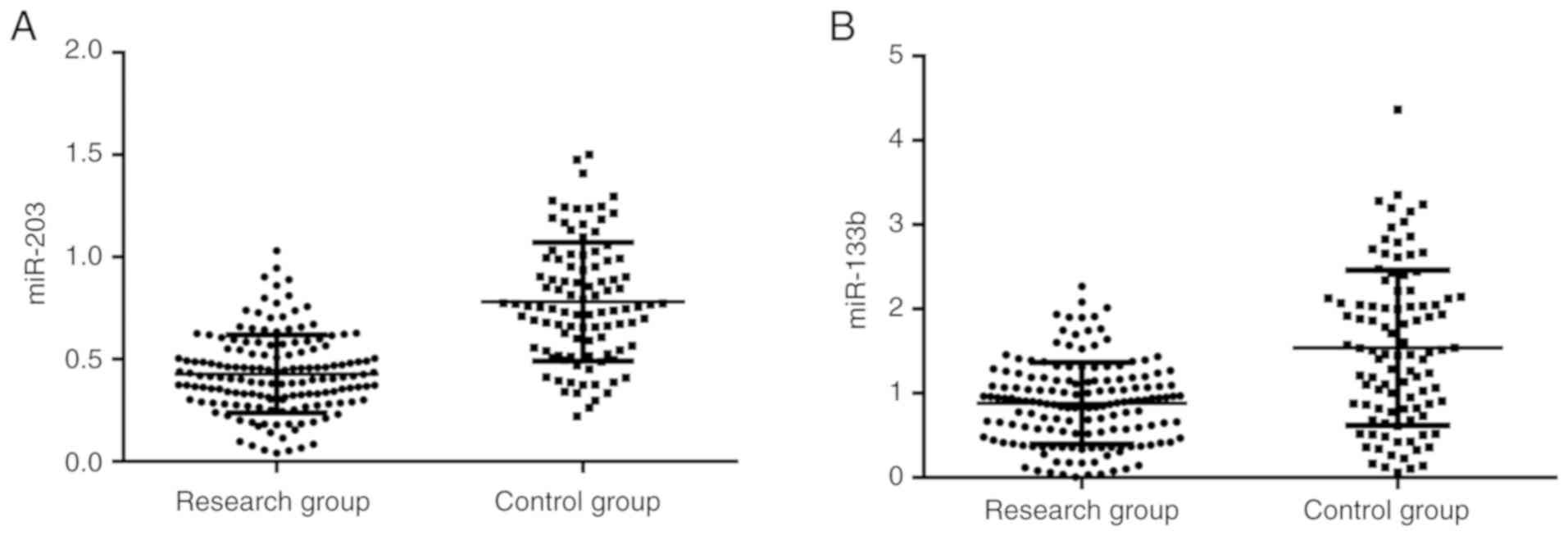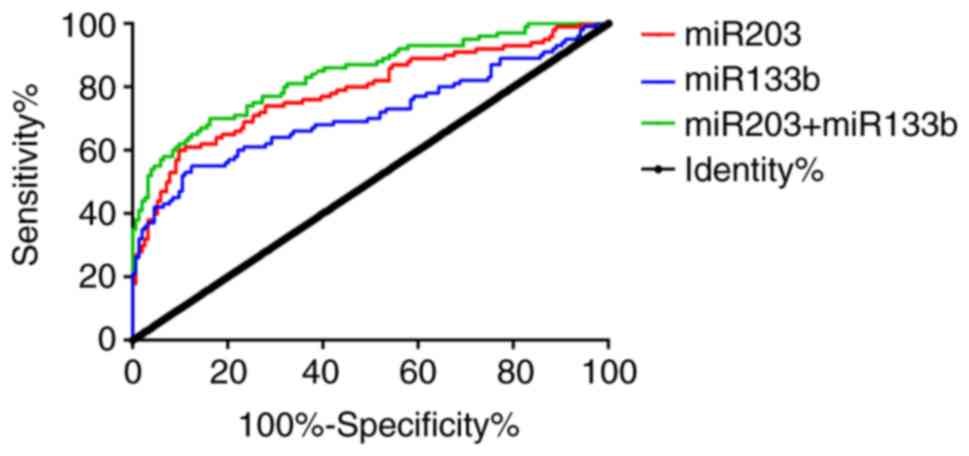|
1
|
Wierzbicka M, Winiarski P and
Osuch-Wójcikiewicz E: The incidence of laryngeal cancer in Europe
with special regard to Poland in last 2 decades. Otolaryngol Pol.
70:16–21. 2016. View Article : Google Scholar : PubMed/NCBI
|
|
2
|
Siegel R, Ma J, Zou Z and Jemal A: Cancer
statistics, 2014. CA Cancer J Clin. 64:9–29. 2014. View Article : Google Scholar : PubMed/NCBI
|
|
3
|
de Souza DL, Pérez MM and Curado MP:
Predicted incidence of oral cavity, oropharyngeal, laryngeal, and
hypopharyngeal cancer in Spain and implications for cancer control.
Cancer Epidemiol. 35:510–514. 2011. View Article : Google Scholar : PubMed/NCBI
|
|
4
|
Lin CC, Fedewa SA, Prickett KK, Higgins KA
and Chen AY: Comparative effectiveness of surgical and nonsurgical
therapy for advanced laryngeal cancer. Cancer. 122:2845–2856. 2016.
View Article : Google Scholar : PubMed/NCBI
|
|
5
|
Aydil U, Akmansu M, Gumusay Ö, Bakkal FK,
Yazıcı Ö, Kızıl Y, Köybaşıoğlu A, Yıldız R, Büyükberber S and İnal
E: Comparison of three different concurrent chemoradiation regimens
for treatment of laryngeal cancer. Eur Arch Otorhinolaryngol.
273:2795–2803. 2015. View Article : Google Scholar : PubMed/NCBI
|
|
6
|
Fararouei M, Daneshi N, Mohammadianpanah
M, Reza Tabatabaei H, Zare-Bandamiri M and Dianatinasab M: Factors
predicting survival in patients with early stage laryngeal cancer:
A cohort study between 2000 to 2015. J BUON. 22:996–1003.
2017.PubMed/NCBI
|
|
7
|
Sethi N, Rafferty A, Rawnsley T and Jose
J: Short, sharp shock public health campaign had limited impact on
raising awareness of laryngeal cancer. Eur Arch Otorhinolaryngol.
273:2747–2754. 2015. View Article : Google Scholar : PubMed/NCBI
|
|
8
|
Fostiropoulos K, Arens C, Betz C and Kraft
M: Noninvasive imaging using autofluorescence endoscopy: Value for
the early detection of laryngeal cancer. HNO. 64:13–18. 2016.(In
German). View Article : Google Scholar : PubMed/NCBI
|
|
9
|
Topuz MF, Binnetoglu A, Yumusakhuylu AC,
Sarı M, Baglam T and Gerin F: Circulating calprotectin as a
biomarker of laryngeal carcinoma. Eur Arch Otorhinolaryngol.
274:2499–2504. 2017. View Article : Google Scholar : PubMed/NCBI
|
|
10
|
Ha M and Kim VN: Regulation of microRNA
biogenesis. Nat Rev Mol Cell Biol. 15:509–524. 2014. View Article : Google Scholar : PubMed/NCBI
|
|
11
|
Arvidsson Y, Rehammar A, Bergström A,
Andersson E, Altiparmak G, Swärd C, Wängberg B, Kristiansson E and
Nilsson O: miRNA profiling of small intestinal neuroendocrine
tumors defines novel molecular subtypes and identifies miR-375 as a
biomarker of patient survival. Mod Pathol. 31:1302–1317. 2018.
View Article : Google Scholar : PubMed/NCBI
|
|
12
|
Nagy Z, Decmann Á, Perge P and Igaz P:
Pathogenic and diagnostic roles of microRNAs in adrenocortical
tumours. Orv Hetil. 159:245–251. 2018. View Article : Google Scholar : PubMed/NCBI
|
|
13
|
He L, Chen Y, Hao S and Qian J: Uncovering
novel landscape of cardiovascular diseases and therapeutic targets
for cardioprotection via long noncoding RNA-miRNA-mRNA axes.
Epigenomics. 10:661–671. 2018. View Article : Google Scholar : PubMed/NCBI
|
|
14
|
Lu ZM, Lin YF, Jiang L, Chen LS, Luo XN,
Song XH, Chen SH and Zhang SY: Micro-Ribonucleic acid expression
profiling and bioinformatic target gene analyses in laryngeal
carcinoma. Onco Targets Ther. 7:525–533. 2014. View Article : Google Scholar : PubMed/NCBI
|
|
15
|
Saito K, Inagaki K, Kamimoto T, Ito Y,
Sugita T, Nakajo S, Hirasawa A, Iwamaru A, Ishikura T, Hanaoka H,
et al: MicroRNA-196a is a putative diagnostic biomarker and
therapeutic target for laryngeal cancer. PLoS One. 8:e714802013.
View Article : Google Scholar : PubMed/NCBI
|
|
16
|
Livak KJ and Schmittgen TD: Analysis of
relative gene expression data using real-time quantitative PCR and
the 2-ΔΔCT method. Methods. 25:402–408. 2001. View Article : Google Scholar : PubMed/NCBI
|
|
17
|
Wei WI and Chan JY: Surgical treatment of
advanced staged hypopharyngeal cancer. Adv Otorhinolaryngol.
83:66–75. 2019.PubMed/NCBI
|
|
18
|
Hsueh C, Tao L, Zhang M, Cao W, Gong H,
Zhou J and Zhou L: The prognostic value of preoperative
neutrophils, platelets, lymphocytes, monocytes and calculated
ratios in patients with laryngeal squamous cell cancer. Oncotarget.
8:60514–60527. 2017. View Article : Google Scholar : PubMed/NCBI
|
|
19
|
Huang YW, Luo J, Weng YI, Mutch DG,
Goodfellow PJ, Miller DS and Huang TH: Promoter hypermethylation of
CIDEA, HAAO and RXFP3 associated with microsatellite instability in
endometrial carcinomas. Gynecol Oncol. 117:239–247. 2010.
View Article : Google Scholar : PubMed/NCBI
|
|
20
|
Zimonjic DB and Popescu NC: Role of DLC1
tumor suppressor gene and MYC oncogene in pathogenesis of human
hepatocellular carcinoma: Potential prospects for combined targeted
therapeutics (review). Int J Oncol. 41:393–406. 2012. View Article : Google Scholar : PubMed/NCBI
|
|
21
|
Yao XD, Li P and Wang JS: MicroRNA
differential expression spectrum and microRNA125a5p inhibition of
laryngeal cancer cell proliferation. Exp Ther Med. 14:1699–1705.
2017. View Article : Google Scholar : PubMed/NCBI
|
|
22
|
Wu B, Xiong X, Jia J and Zhang WF:
MicroRNAs: New actors in the oral cancer scene. Oral Oncol.
47:314–319. 2011. View Article : Google Scholar : PubMed/NCBI
|
|
23
|
Tian L, Li M, Ge J, Guo Y, Sun Y, Liu M
and Xiao H: miR-203 is downregulated in laryngeal squamous cell
carcinoma and can suppress proliferation and induce apoptosis of
tumours. Tumour Biol. 35:5953–5963. 2014. View Article : Google Scholar : PubMed/NCBI
|
|
24
|
Pakkanen PP, Aaltonen LM, Sorsa TA,
Tervahartiala TI, Hagström JK and Ilmarinen TT: Serum matrix
metalloproteinase 8 and tissue inhibitor of metalloproteinase 1:
Potential markers for malignant transformation of recurrent
respiratory papillomatosis and for prognosis of laryngeal cancer.
Head Neck. 41:309–314. 2018.PubMed/NCBI
|
|
25
|
Memar MY, Alizadeh N, Varshochi M and
Kafil HS: Immunologic biomarkers for diagnostic of early-onset
neonatal sepsis. J Matern Fetal Neonatal Med. 32:143–153. 2017.
View Article : Google Scholar : PubMed/NCBI
|
|
26
|
Zhao FX, Liu GH and Zhang J: Value of IL-6
and IL-8 in the diagnosis of neonatal sepsis. Zhongguo Dang Dai Er
Ke Za Zhi. 17:1311–1315. 2015.(In Chinese). PubMed/NCBI
|
|
27
|
Wang W, Xu X, Tian B, Wang Y, Du L, Sun T,
Shi Y, Zhao X and Jing J: The diagnostic value of serum tumor
markers CEA, CA19-9, CA125, CA15-3, and TPS in metastatic breast
cancer. Clin Chim Acta. 470:51–55. 2017. View Article : Google Scholar : PubMed/NCBI
|
|
28
|
Xu F, Li Y, Fan L, Ma J, Yu L, Yi H, Chen
X, Wei W, Wu P, Liang L, et al: Preoperative SCC-Ag and
thrombocytosis as predictive markers for pelvic lymphatic
metastasis of squamous cervical cancer in early FIGO stage. J
Cancer. 9:1660–1666. 2018. View Article : Google Scholar : PubMed/NCBI
|
|
29
|
Kerr D, Laber D, Visweshwar N and Jaglal
M: Case report: CEA elevation can be a marker of increased
inflammation during treatment with oxaliplatin. Anticancer Res.
38:1711–1713. 2018.PubMed/NCBI
|
|
30
|
Kwack JY, Roh HJ, You SG, Cho HJ, Lee SH
and Kwon YS: Chemotherapy-induced hemolytic uremic syndrome in
locally advanced cervical cancer treated with combination
chemotherapy after laparoscopic radical hysterectomy: A case report
and review of the literature. Eur J Gynaecol Oncol. 38:956–959.
2017.
|
|
31
|
Chen X, Chen XG, Hu X, Song T, Ou X and
Zhang C, Zhang W and Zhang C: miR-34a and miR-203 inhibit survivin
expression to control cell proliferation and survival in human
osteosarcoma cells. J Cancer. 7:1057–1065. 2016. View Article : Google Scholar : PubMed/NCBI
|
|
32
|
Chen X, Wu B, Xu Z, Li S, Tan S, Liu X and
Wang K: Downregulation of miR-133b predict progression and poor
prognosis in patients with urothelial carcinoma of bladder. Cancer
Med. 5:1856–1862. 2016. View
Article : Google Scholar : PubMed/NCBI
|
















